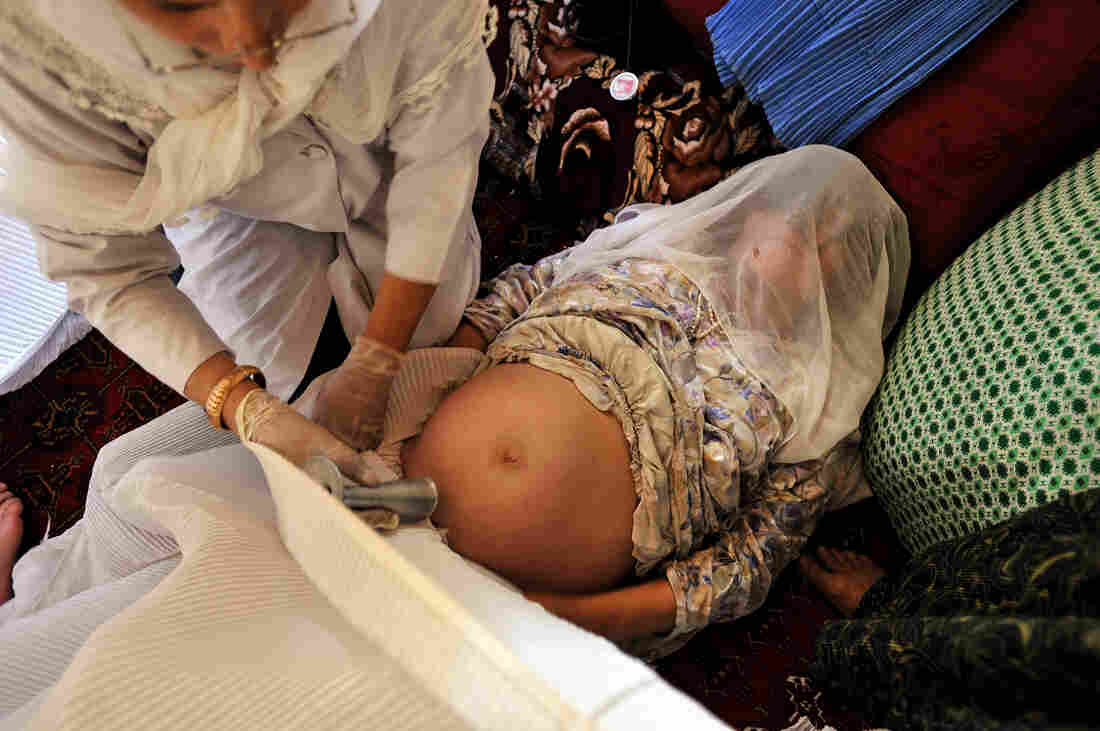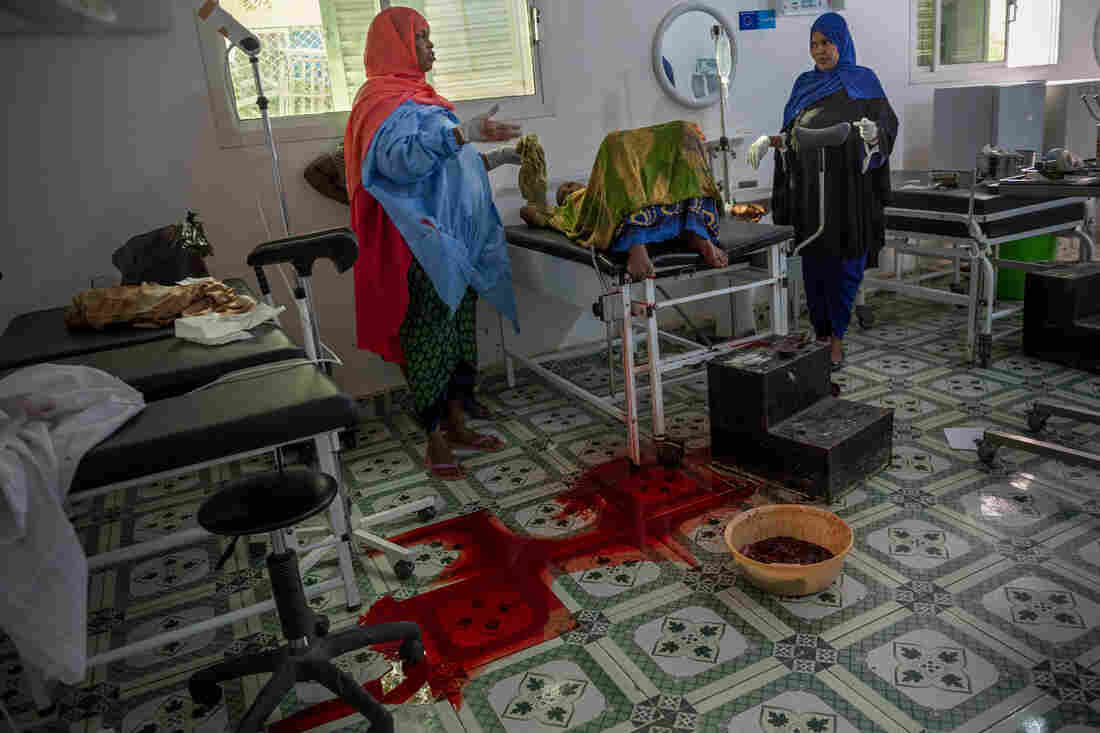Trump Drops Plan To Host G-7 Summit At His Miami Resort

Trump abandoned his plan to host the next G-7 summit at his Doral, Miami, golf resort, on Saturday.
Alex Sanz/AP
hide caption
toggle caption
Alex Sanz/AP
President Trump announced that he’s dropping his plan to host next year’s Group of Seven meeting of the leaders of the world’s biggest economies at his Miami-area golf club.
In a series of late-night tweets on Saturday, Trump blamed the reversal on what he described as “Media & Democrat Crazed and Irrational Hostility,” following bipartisan claims that he’s exploiting his presidency for personal profit.
“I announced that I would be willing to do it at NO PROFIT or, if legally permissible, at ZERO COST to the USA. …” the president tweeted. “[B]ased on both Media & Democrat Crazed and Irrational Hostility, we will no longer consider Trump National Doral, Miami, as the Host Site for the G-7 in 2020.”
He again touted his resort’s “grand” acreage, ample rooms and its proximity to the Miami International Airport as an ideal venue to host international leaders.
Trump said his administration “will begin the search for another site, including the possibility of Camp David, immediately.”
Acting White House Chief of Staff Mick Mulvaney had announced on Thursday that Trump National Doral would be the site of the 2020 summit. The selection revived accusations about Trump’s ability to use his office for financial gain and claims that he’s violated the Constitution by collecting payments from foreign governments going to businesses he owns.
Since the early days of his presidency, Trump has faced multiple ongoing lawsuits alleging he is violating the Emoluments Clause of the Constitution, which prohibits a sitting president from accepting payments from foreign governments.
Noah Bookbinder, the executive director of Citizens for Responsibility and Ethics in Washington, one of the groups suing Trump over the emoluments issue, said Trump’s Saturday announcement was “a bow to reality, but does not change how astonishing it was that a president ever thought this was appropriate, or that it was something he could get away with.”
Democratic House leaders had planned a vote as early as this week to rebuke Trump over the decision. They also planned investigations into the selection process and suggested they would prevent government money from being spent at Trump properties. A number of Republicans in Congress had also voiced concerns with the Doral choice.
An hour before Trump canceled the Doral plan, Democratic presidential candidate Joe Biden issued a rebuke on Twitter.
“Hosting the G7 at Trump’s hotel? A president should never be able to use the office for personal gain,” the former vice president wrote.
During Thursday’s press briefing, Mulvaney dismissed the possibility of returning to Camp David to hold the gathering, describing it as “too small” and “too remote.”
“I understand the folks who participated in it hated it and thought it was a miserable place to have the G-7,” he said.
NPR’s Brett Neely contributed to this report.
Saturday Sports: World Series
It’s all about baseball as NPR’s Scott Simon talks with ESPN’s Howard Bryant about the World Series matchup, and about Yankees fans behaving badly.
Congo’s KOKOKO! Makes Joyful Dance Music From Instruments Made Of Junk

KOKOKO!, a band from the Democratic Republic of Congo, performs at an NPR Tiny Desk Concert that will be posted at a future date.
Bob Boilen/NPR
hide caption
toggle caption
Bob Boilen/NPR
Before the members of Congolese music collective KOKOKO! take the stage at Washington, D.C.’s Rock & Roll Hotel, they slip into bright yellow jumpsuits.
The fashion choice, they explain, has utilitarian roots: That’s what a lot of workers in Congo wear. Their instruments have a similar no-frills style — they were crafted from kitchen pots, tin cans and air-conditioner parts.
“It started out because commercial instruments in Kinshasa [where they live] are too expensive to buy and also too expensive to rent. So it started with the necessity of creating your own guitar or your own bass,” says member Boms Bomolo.
The group’s name reflects their humble origins. “KOKOKO” means “knock knock knock” in the local language, Lingala. When they were getting started in 2016, they picked it as a call-out for somebody to open the door and let their music in.
And the door is definitely open for their joyful dance music, with energetic percussion, electronic beats and call and response vocals between the band members and audience. Even if the crowd at Rock & Roll Hotel doesn’t understand the Kikongo, Lingala, French and Swahili lyrics, they eagerly repeat the words back to singer Love Lokombe.
YouTube
In their first two years, KOKOKO! toured the world and released a slew of singles and an EP. They dropped their debut LP, Fongola, in July to rave reviews. Earlier this year, their performance at South by Southwest music festival in Austin, Texas, caught the attention of NPR’s All Songs Considered. Now wrapping up their first big tour across North America, they stopped by NPR’s Tiny Desk on October 1.
During the concert, the group’s instrumental inventory included rows of plastic containers, pots and pans and a guitar fashioned out of two cans and a wooden fretboard. Some of the objects were ready to be played with no adjustments, like the metal kitchen pots used for percussion. Others, like the drum kit that features parts of an old air-conditioning unit, took a bit more assembly — the musicians had to go out, collect scraps and combine them into one cohesive instrument.
Perhaps their greatest creation is a “monumental human-size bass harp,” as described by member Xavier Thomas — made from a wooden cross, metal cans and a plastic barrel. They call it “Jesus Crisis,” a humorous reference to evangelical churches in Congo, which Thomas says can get quite “inventive” with their religious interpretations. The harp was made by group member Dido Oweke, who, according to his bandmates, visualizes the instruments he wants to make as sculptures first.
KOKOKO! member Dido Oweke built the “Jesus Crisis” bass harp in 2016.
Xavier Thomas
hide caption
toggle caption
Xavier Thomas
“We brought [the harp] once on tour, but it’s so hard to transport. It’s like moving a house,” says Thomas, also known as Débruit when he does solo electronic music projects. Thomas, originally from France, is the only member of the band not from Congo; he acted as the interpreter for the other musicians interviewed for this story.
Thomas met his bandmates while working on a music project in Kinshasa. They jammed together at a block party in 2016 and formed the group shortly after.
The music itself, which combines homemade instruments with electronic synths, channels the sounds and spirit of KOKOKO!’s birthplace. Kinshasa, home to an estimated 12 million people, has a rich aural landscape, according to Bomolo, Thomas and percussionist/vocalist Makara Bianko. Street vendors clink nail polish bottles together. Shoeshiners call out to customers. Megaphones blast recorded advertisements for cellphone credits on a perpetual loop.
“With your eyes closed, you can tell who’s where — at what distance,” Thomas explains. “Boms is inspired by the sonic chaos and reorganizes it into music.”
KOKOKO!’s high-powered performance, yellow jumpsuits and all, is a demand to be seen and heard in the middle of Congo’s vibrancy — but they also make a point on their website and during the interview to highlight the challenges faced by Congolese people.
The world sees Congo as an Ebola hotspot — the country is currently is facing the second largest outbreak in history. But the musicians say the virus does not play into daily life in Kinshasa, which is more than a thousand miles away from the affected area. The members of KOKOKO! have other concerns, like violence, corruption and poverty. The World Bank estimates that 73% of Congo’s population lived in extreme poverty in 2018.
Congo is rich in natural resources, making it a top producer of metals like cobalt and coltan. But Bianko believes that the wealth from those resources mainly profits industrialized nations and the multinational corporations that mine in Congo.
“Every time the industry needed something in the world, they found it in Congo, but they didn’t leave anything behind,” says Bianko.
The Congolese way is to not let those struggles haunt their everyday life, says Bianko. People in Kinshasa maintain a spirit of resistance, the group explains — of not letting the financial and political turmoil affect their ability to get dressed up, go out, have fun. Or make music.
That’s why the magic of KOKOKO! is not just that they worked with what they could find to make music. It’s that they dove deep into the research of harnessing sounds from unusual objects and became a project of sonic revolution in the process.
“Now, this is what makes our sound, these instruments,” says Bianko, noting that they’re still adding new objects to their repertoire with every tour. “We wouldn’t switch back [to traditional instruments] because these instruments are the identity of the band.”
The “knock knock knock” of their names has evolved as well. As political instability rocked Congo in 2017, they were literally knocking on the doors of embassies across Kinshasa, trying to get visas approved so the band could tour internationally.
Now, they say, they’re knocking on people’s consciousness “to open up to the kind of musical innovation we’re proposing.”
For more info on Tiny Desk Concerts sign up for the NPR music newsletter.
PHOTOS: Why Lynsey Addario Has Spent 10 Years Covering Maternal Mortality

Addario’s coverage of maternal mortality took her to a remote village in Badakhshan province, Afghanistan in 2009, where she photographed a midwife giving a prenatal check in a private home. “In these areas someone will announce that a doctor and a midwife are coming, and any pregnant and lactating women within a certain radius come if they want prenatal or postnatal care,” she says.
Lynsey Addario
hide caption
toggle caption
Lynsey Addario
Editor’s note: This story includes images that some readers may find disturbing.
When photojournalist Lynsey Addario was awarded the MacArthur Fellowship in 2009, she took it as a chance to work on a topic that many photographers and editors shied away from: maternal mortality. Her photos of overcrowded hospitals, bloody delivery room floors and midwives in training illustrate the challenges women face in childbirth and what the global health community is doing to overcome it. The series was featured at this year’s Visa Pour L’image festival in Perpignan, France.
Addario has borne witness to some of the most intense global conflicts of her time. She has worked for publications like The New York Times, National Geographic and Time Magazine and has covered life under the Taliban in Afghanistan and the plight of Syrian refugees. She has been kidnapped twice while on assignment, most recently in Libya in 2011 while covering the civil war.
Every two minutes, a woman dies from childbirth or pregnancy-related causes, and many of these deaths are entirely preventable. While the global health community has made great strides bringing down the rate of these maternal mortalities since efforts intensified in the early 1990s, the reality for many mothers is still harrowing.
We spoke to Addario, author of the 2015 memoir It’s What I Do: A Photographer’s Life of Love and War, about what drives her work and what she’s witnessed over a decade of reporting on this topic. The interview has been edited and condensed for clarity.
Addario recalls visiting Tezpur Civil Hospital in Assam, India, “where there’s tea plantations all around. In that area I was looking at the conditions for women, and you can tell that [the hospital] is grossly overcrowded. There were women waiting to deliver, some had already delivered — there were even women sleeping in the hallways of this hospital on the stairs leading up to the main ward.”
Lynsey Addario
hide caption
toggle caption
Lynsey Addario
How did you get interested in the topic of maternal mortality?
In 2009 I was named a MacArthur Fellow. It was the first time in my career where I was given money to work on a project without an assignment, so I could choose something that I felt was important to cover. I started learning about the incredible number of women who were dying in childbirth every year. It wasn’t a story that was easy to get published — I think most editors felt it wasn’t a sexy topic. Most people just don’t realize what a big deal this is.
[Early in the project,] in the very first hospital I walked into outside of Freetown, Sierra Leone, I literally watched a very young woman, Mamma Sessay, hemorrhage in front of me on camera and die. And I knew that it was a story I had to continue with.
You write in your book Of Love & War that what compels you to do photojournalism is “documenting injustice.” How does that apply in this series?
If you’re a poor woman living in a village where there are no medical professionals around, and you don’t have enough money to get to a hospital, then you run the risk of dying in childbirth. That’s injustice. I think everyone is entitled to a safe delivery. In 2019 there should be medical facilities within reach for anyone to be able to access them, or mobile clinics.
“This is a fistula repair in Kabul, Afghanistan, with two surgeries going on side by side,” Addario says. “A fistula is a tear, often between the vagina and the anus. It’s common in many countries with child marriage, or where women have birth very young. It’s quite a shame — often women are shunned from their houses or don’t get care — there’s often a smell associated with fistula.”
Lynsey Addario
hide caption
toggle caption
Lynsey Addario
Were you a mother when you started the project?
No. In fact I always used to joke around on the delivery ward that I would never become a mother because I had photographed so many women delivering, and I knew it was such a painful and difficult experience. Then in 2011 I gave birth to my first son, so I ended up doing it anyway. Even though this project made me more scared to actually deliver because I know how many things can go wrong.
Ironically my own delivery in 2011 was not a great experience. I moved to London when I was 32 weeks pregnant and delivered at 37 weeks. I had no doctor, basically just showed up at the hospital nine centimeters dilated and delivered with whatever midwife was on duty. Now that I’ve been doing this project for 10 years, there are so many things I would suggest to first-time mothers — or second-time mothers.
Like what?
Like maybe have a doula or have someone with you who can be an advocate — who can explain to you what’s going on with your body, who can help you navigate the pain. Someone who can understand if something’s going wrong, like the symptoms of preeclampsia: headaches, sweating, swelling. There’s so much that we just don’t know, that we’re not taught. People take childbirth for granted.
What is it like talking to your male colleagues about this project?
Most of them just haven’t paid attention to this work. Colleagues have said things to me about some stories — like the woman giving birth on the side of the road in the Philippines and the Mamma Sessay story — because they’re sensational, but no one really asked me about the work, which is interesting in and of itself. I think people sort of shy away from talking about birth, you know? Unless it’s something happy and positive.
“This is part of Dr. Edna Ismail’s team doing outreach in a remote village in Somaliland,” Addario says. “They do a similar thing like in Afghanistan, where they make an announcement for any pregnant and lactating women to come for a prenatal check. That’s essentially the only way women can get care unless they walk or are able to get transport to the nearest hospital or clinic.”
Lynsey Addario
hide caption
toggle caption
Lynsey Addario
What has surprised you while photographing this series?
How much access people give me. I’ve photographed — I can’t even count how many — probably three or four dozen births. The women invite me into very intimate spaces. I obviously try to be very respectful of how I photograph something like this. It’s one of the most beautiful things I’ve ever witnessed, watching a baby be born. It’s something delicate to photograph because it’s so incredible and at the same time it’s very graphic. It’s hard, and it’s always surprising to me how many people have let me in.
That word “graphic” jumps out at me. I’m looking at one of your photos now, where there’s blood on a delivery room floor, and it’s uncomfortable in a way that’s different than looking at blood from violence.
A mother receives postnatal care in a Somaliland hospital. “She was brought [there] in a wheelbarrow,” Addario recalls. “She delivered her baby stillborn then started hemorrhaging. It was extraordinary for me to witness — it was very similar to what I’d seen a decade earlier when Mamma Sessay died but in this case the woman survived because there were trained midwives who knew exactly what to do.”
Lynsey Addario
hide caption
toggle caption
Lynsey Addario
It is different. It’s different because no one thinks of childbirth like that. They think of childbirth as Hallmark pictures, but there’s a lot that’s not beautiful about it.
You’ve been working on this project for 10 years now. What has changed?
The statistics [for maternal mortality] have gone down, which is incredible, and there’s a lot more awareness. There are so many organizations — like Every Mother Counts, which is Christy Turlington’s organization, and UNFPA and UNICEF — working to fight maternal death. There’s more information, but it’s still too many — one woman a day is too many.






